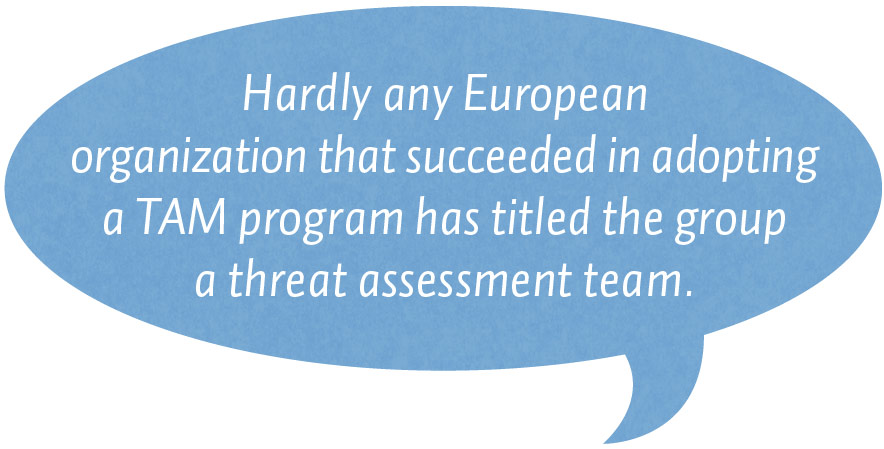Translating Your Threat Assessment Approach
Threat assessment and management (TAM) procedures are not universally effective. What is considered common sense in the United States is often received in Europe with skepticism, resistance, and, in some situations, even disdain. A U.S. company’s workplace violence training programs and approaches can fail to find fertile soil in its European branches. Developing and setting up a threat management program to work internationally needs restructuring and reframing to make it more acceptable for different teams.
What Is Threat Assessment and Management?
On a basic level, TAM deals with both the assessment and the management of people posing a concern for violence. This form of threat assessment is different than traditional (forensic) risk assessment that occurs when—usually—an aggressive incident has already taken place and the perpetrator is available for evaluation, psychological testing, and diagnostics. In this case, the assessor has the time and multiple information sources to investigate and discuss the case with colleagues.
There are a few similarities with behavioral threat assessment, particularly the goal: violence prevention. But the threat assessment professional operates in a much more dynamic context. In many cases a serious incident has not taken place yet, but people working or living with the person of concern are worried and fear escalation or serious violence.
One of the main concepts in TAM is the early detection of problem behavior. After all, the aim is violence prevention and de-escalation before things get really bad. This means that the corporate threat management team needs to focus on lower-level concerning behaviors such as harassment, stalking, and threatening behavior and, through partnerships with different disciplines, try to resolve the situation and restore a safe and productive work environment. This approach clearly stands in contrast with solely preemptive installation of strong outward security measures, focusing on the protection of the organization for the worst-case scenario—something that is statistically less likely to occur.
At the same time, the threat assessor has to manage fear among colleagues and staff, deal with the organizational dynamics caused by the misbehavior, work with external parties such as police or psychiatric care facilities, and de-escalate and stabilize crises with sustainable threat management interventions. It is a multidisciplinary task.
In his book Trigger Points: Inside the Mission to Stop Mass Shootings in America, author and journalist Mark Follman suggests that the TAM approach to violence in the United States is considered the most effective way to accomplish safety in schools and higher education facilities. In North America and Canada, the problem of workplace violence is acknowledged, and the establishment of threat management teams is relatively well accepted. Serious violent incidents taking place at workplaces through the years have helped to raise awareness, both within organizations and on a government level.
In Europe, however, organizations notice an increased social and political pressure to pay serious attention to social safety and install professional threat management services in their organizations. Also, serious incidents such as the Germanwings airplane crash in 2015 contributed to higher awareness among multinationals of mental health problems, behavioral concerns, and safety. Especially in higher education, there has been a strong increase of management programs to deal with concerning behaviors. This pattern is likely to continue, alongside an increase in threat management teams within globally operating, European-based companies.
The Prevalence of Violence
The TAM principles and methodology are relevant to any organization, no matter where the organization is geographically located. The way violence presents itself in the workplace may vary from industry to industry, and violence may come in different forms. But all organizations are vessels for inevitable conflict, stress, disappointment, and loss—this is not culturally or geographically determined, according to the International Handbook of Threat Assessment. Behaviors such as stalking, bullying, harassment, and intimidation are found in all organizations of any size. No workplace can presume to be immune: not in America, not in Asia, and not in Europe.
It is a well-known social phenomenon that violence is often not reported to law enforcement or other authorities. Research in The Netherlands by the Central Bureau of Statistics repeatedly indicated that the public will report violent crime in around 20 percent of all cases; for violent, property, and vandalism offences combined, only 32 percent of crimes were reported to police in 2019.
Do not expect that workplace violence or misconduct is reported more often by victims. We know from multiple years of casework that, for several reasons, people are unlikely to go to their bosses, to the HR representative, confidential advisor, or corporate security manager to tell them about what they have seen happening to colleagues or about their own victimization.
One of the tasks of a corporate threat management team is to raise awareness and lower resistance for employees to come forward.
Fine-Tuning TAM for European Organizations
The TAM approach has a strong appeal in the United States because of the prevalence of gun incidents and shootings at the workplace, although TAM is far more than that. Because of that connotation and the strong emphasis in the United States on mass-murder incidents, TAM needs a different introduction and framing in European countries.
Professional trainers teaching threat assessment in Europe should be aware that terminology associated with strong physical violence and criminal behavior does not sound appealing to the European corporate world. Also, using extreme examples of mass murder and gun violence to illustrate TAM does not resonate within the European work context. This approach does not appeal to the needs of European organizations, mainly because of the low base rate of gun incidents and perhaps also because of subtle cultural differences.
There is more attention paid these days to physical and social safety in European organizations due to heightened public emphasis on harassment, intimidation, and the #MeToo movement. TAM is aimed at the early detection of people exhibiting concerning behaviors relating to and preceding phenomena like harassment, threats, stalking, conspiracy, suicide, and other forms of workplace violence.
However, a few more incentives can help make the TAM approach acceptable in the European context: the differences in culture of litigation, the focus on privacy rights, and the focus on the individual of concern. This will lead to a fourth, final point—reframing the TAM approach by using different language and a different position in the organization will lead to better acceptance.
The Absence of a Culture of Litigation
Europe and the United States as societies differ when it comes to a culture of litigation. There is no real imperative to introduce TAM in Europe other than the conviction that the organization has a moral responsibility to protect employees. Nevertheless, taking legal action against someone else—for example, your employer—does not come so naturally in the European Union. It does not resonate with broad European cultural values.
Besides the absence of frequent mass shootings, this is one of the reasons why European companies do not have workplace violence high on their agenda. A company or company officials being held accountable for workplace violence is not commonplace in many European countries. It is noteworthy, though, that this appears to be slowly moving towards a more American approach, with additional legal culpability for company leadership.
The incentive to introduce TAM programs in Europe should not be on litigation but on employee well-being. An employee who feels safe and respected will better perform. Additionally, having a violence prevention program also contributes to the company’s good reputation.
Privacy Rights
The TAM approach focuses on early warning indicators so serious incidents can be prevented. Information gathering and some form of investigation is often necessary for TAM, and this sensitive information not only needs to be assessed but also shared to make the process of violence prevention possible. Prevention simply requires access to information and the removal of silos between organizations and different departments.
“Safety trumps privacy,” corporate security and safety managers often say. Their frustration grows when assessing a safety concern and HR or legal interferes with their action plan by stepping on the brake when data collection and sharing is at stake. Is the organization allowed to collect information from different sources and make a behavioral risk profile of an employee? Can we do this without informing the employee? Is a concerned HR manager allowed to share information about or received from an employee with the corporate threat management team?
In Europe there is a strong movement embracing the protection of personal data and making it more difficult to find and use personal information of employees and students. This movement received a strong impetus a few years ago and has been backed up by the General Data Protection Regulation (GDPR). This is having an impressive effect on threat management programs in organizations, and it creates challenges for the European TAM approach.
European threat managers struggle with the privacy issue in their mission to improve safety at the workplace. North American counterparts often raise eyebrows when European security professionals have to explain to them that certain steps in a case cannot be taken due to privacy rights and related legal barriers.
American institutions concerned about behavior of an employee working for them on European soil are advised to seek professional support from local experts about what the possibilities are and which steps can or should be taken. Local TAM professionals might benefit from similar support in the face of new positions and regulations.
In the past few years, a new position has been introduced to organizations: the privacy officer. Especially in higher education, security professionals are increasingly confronted with resistance coming from this office when they work on cases or while implementing a threat management process.
Many security professionals are not well informed about GDPR and miss the understanding of what is and what is not allowed to be shared. In higher education in particular, it can benefit TAM professionals to bring a legal expert along to the first meetings and have this expert explain why many aspects of the TAM approach do not need to conflict with privacy rights. It makes a big difference in general to take the position of looking into options, what can be done, and what is allowed rather than just saying “no,” whether the TAM professional is dealing with a privacy officer or not.

This can be complicated. In 2019, a Dutch university requested that the authors assess and manage an incident. A student posed a serious danger to female students due to severely aggressive and ongoing stalking, as well as other forms of misbehavior. This individual had behaved in a problematic and concerning way in the past. Due to privacy regulations, there was no file available that could give us insight into his past behavior, which would certainly have been relevant to help us understand and intervene the current threatening situation. Important past incidents weren’t registered, and it took a significant portion of time to understand the danger the student posed. We had to spend time identifying the victims he targeted in the past, and that was time we could not use to take any action against him—allowing him to continue his misbehavior.
Eventually, it took a lot of effort to expel the student from campus. Once expelled, however, he could immediately register at another university only 30 miles down the road. The university the authors worked for was not allowed to share its serious concerns with the other university. The second university has to wait until the student engages in misbehavior and someone—a victim or a bystander—takes the difficult step to report it.
Focusing on the Individual
The perception of serious violence as a daily concern in society strongly indicates where interventions should be sought.
For instance, a Dutch school, Alfa College in Hoogeveen, announced in 2018 that it planned to organize a simulation of a school shooting to test preparedness. The result was public outrage. Parents sent letters of concern and demanded that the event be immediately canceled. The national media spoke of absurdity and fear mongering. Only the police said it was a good idea, although they worded their response very carefully. The response astounded the authors’ American colleagues because school shootings are a sad reality of the U.S. educational landscape and active assailant drills are now commonplace in schools.

While it is true that the incidence rate of an active shooter appearing at a Dutch school is statistically very low in The Netherlands, it certainly does not mean that the danger of serious violence is absent. There are multiple examples of severe violence committed by students in European educational institutions. The rate of knife stabbing incidents among teenagers has climbed to an alarming level in the last few years in The Netherlands. In many schools, the issue needs attention, but TAM-like programs are mostly absent. Why?
As a society, many Europeans prefer to keep a distance from the idea that we need to do something because a violent school incident could happen again or that risk is on the rise. We also have a tendency to decriminalize the violent act. It is much more comfortable to Europeans to perceive a killing as an exceptional, individual mental health problem of a youngster who we should have cared for better, rather than labelling it as a heinous murder committed by a violent perpetrator. Historically, Europeans prefer to focus on offender care more than victim protection. Therefore, it is not the school’s responsibility to set up intrusive detection and preventive measures against violence—we as society should do better with the derailment of youngsters, their mental health, and their disrupted families.
How could a TAM approach be helpful in this difficult situation? Start with framing TAM differently. The starting point should not be serious violence, but specific circumstances and indicators that function as a signal for problematic escalation. Steer away from language such as “perpetrator,” “mass murderer,” “active shooter,” “offender profiling,” or “threat management teams.” Instead, reformulate efforts in terms of personal care and prevention.
The resistance to focus on an individual and the risks he or she poses is deeply entrenched in the European mindset, and it affects more than just TAM procedures. Many companies will shy away from thorough and behavioral pre-employment screening out of concern for the person’s privacy. Organizations are concerned that a future employee will perceive the procedure as an act of distrust and a negative statement from the organization.
Through the years of working on cases in organizations, terms such as “growth potential,” “talent development,” “personal improvement through coaching,” and “promoting a positive culture” form the mindset of many European HR managers. Surprisingly, this perspective is often not subject to change when discussing an employee’s serious and ongoing misconduct. Understandably, these conflicting perceptions can clash in TAM professionals’ attempts to explain that some people have violent intent, can cause damage to other people, and that this behavior will never stop—nor will the person change.
Changing Vocabulary and Broadening the Scope
The aforementioned factors lead to a puzzling situation: there is serious violence in Europe, but the existing American TAM approach faces resistance. To a large extent, it boils down to language and positioning. Language has a strong impact on people’s perceptions and feelings. There is a story of a Belgian restaurateur who once changed the name of an item on his menu from “pony” to “grassbelly” (because of the small size of the pony, its belly often touches the long grass), and the customers suddenly started to appreciate it more. Nevertheless, they were still eating the same meat.
Similarly, if the intention is to make TAM principles effective in Europe, one first has to start with a change of terminology and—in part—content. Adaptations are needed in the professional judgment tools and other threat assessment instruments used to identify and assess warning behaviors. Practicing threat assessment professionals in Europe agree that “workplace violence” holds negative connotations for companies and organizations, and it stimulates the under-acknowledgement of the issue. One has to be careful with the terminology when speaking about workplace violence. Terms such as “sexual violence at the workplace,” “risk for violence,” “attack,” “threat,” or “predator” are neither welcomed nor found appropriate in much of the European corporate world.
Although there is definitely workplace violence in European organizations and therefore room for TAM as a method to deal with serious violence, one has to phrase it differently: problematic behavior, unwanted behavior, counterproductive behavior, or concerning behavior.
Hardly any European organization that succeeded in adopting a TAM program has titled the group a threat assessment team. Instead, they chose behavioral expert teams, care and support teams, or social safety teams. This branding shift leads to more acceptance. The method reflects a focus on lower-level concerns, which suddenly makes the implementation of a threat assessment and management team much more acceptable. Violence is just one reason why these teams exist, so TAM is incorporated under the umbrella of care and security.
The authors changed their terminology from threat assessment to a “structured approach to concerning workplace incidents,” or SACWI instead of TAM. This shift enables threat assessment professionals to gain much more positive attention from organizations. Instead of being perceived as corporate police psychologists, the authors became more appreciated as consultants to deal with concerning behavior and social safety in the workplace. Even with this change in language, in both the approach and the methodology the principles behind TAM are still in place, showing that it can have a fruitful future in European organizations.
Bram B. Van der Meer and Cornelis van Putten are the owners of Dantes Psychology Services. They are investigative psychologists with a strong focus on concerning behavior in organizations. Reach out to them at [email protected].












